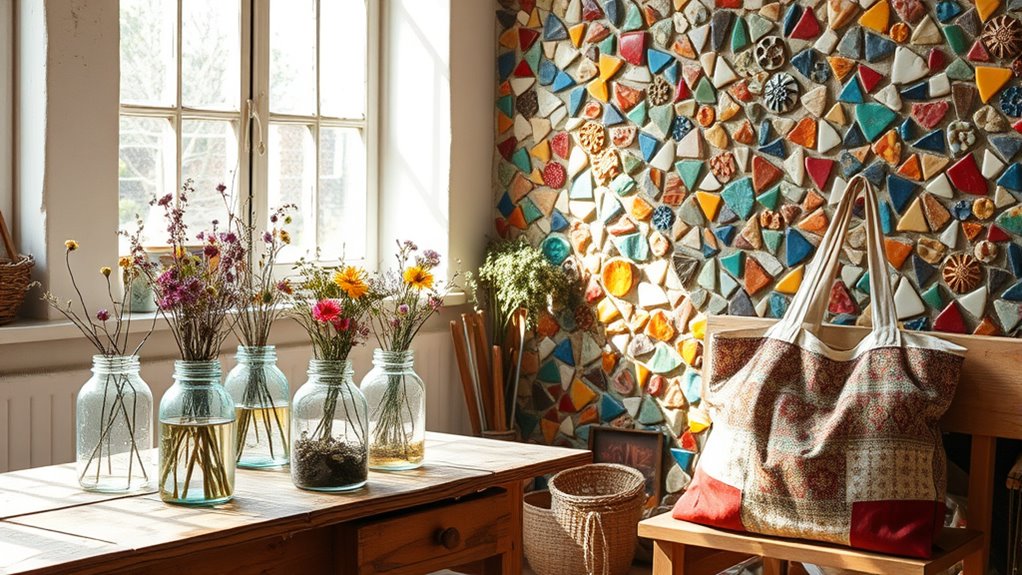Upcycling as a lifestyle means intentionally turning waste into valuable, unique items through your creativity and effort. You can incorporate it into daily routines by repurposing household objects or taking part in workshops and community events. This approach not only helps reduce waste and save money but also boosts your confidence and sense of community. If you want to see how these practices can become a natural part of your life, explore further to discover inspiring ways to upcycle every day.
Key Takeaways
- Incorporate upcycling into daily routines by repurposing household items and waste into functional or decorative objects.
- Participate in creative workshops to develop skills and confidence in transforming discarded materials.
- Engage in community events like swap meets and clean-up days to share ideas and promote sustainable living.
- Foster a mindset that sees waste as raw material, encouraging resourcefulness and environmental responsibility.
- Build a supportive network of like-minded individuals to inspire ongoing upcycling projects and collective eco-conscious efforts.

Embracing upcycling as a lifestyle practice means transforming what others see as waste into something valuable and unique. You start to see potential in discarded items, realizing that trash can become treasure with a little creativity and effort. One of the most effective ways to deepen your understanding and skills is by participating in creative workshops. These workshops often cater to all skill levels, guiding you through techniques like painting, sewing, and furniture restoration. As you learn, you gain confidence in turning old, unloved objects into stylish, functional pieces that reflect your personality. Attending these workshops also connects you with like-minded individuals who share your passion for sustainability and craftsmanship. It’s an inspiring environment where ideas flow freely, and you pick up tips that help you repurpose items more effectively. Incorporating upcycling into your daily routine can be as simple as repurposing household items or exploring new techniques to refine your craft.
Community events are another essential aspect of making upcycling a lifestyle. They serve as gathering points where you can showcase your projects, exchange ideas, and learn from others’ experiences. These events might include swap meets, craft fairs, or local clean-up days that promote sustainability and creativity. By taking part in community events, you become part of a collective effort to reduce waste and promote eco-conscious living. You’ll find opportunities to donate items, exchange materials, or even collaborate on larger upcycling projects. Such gatherings foster a sense of belonging and show you how your individual efforts contribute to a bigger movement. Plus, community events often feature demonstrations and talks that expand your knowledge of eco-friendly practices, inspiring you to experiment with new techniques. Additionally, understanding the importance of secure storage like a Bitcoin IRA wallet can help ensure your projects and materials are protected.
The combination of creative workshops and community events makes upcycling more than just a personal hobby; it becomes a shared experience that empowers you to make a difference. These activities motivate you to see beyond the immediate usefulness of items and to explore creative possibilities. You learn to think differently about waste, viewing it as raw material for your next project. Additionally, they help you build a network of supportive, passionate individuals committed to sustainable living. The more you engage, the more natural upcycling feels—like second nature, integrated into your daily routines. Over time, you’ll find that upcycling enhances your creativity, saves money, and reduces your ecological footprint. It’s a lifestyle that celebrates resourcefulness, craftsmanship, and community, making a meaningful impact one repurposed item at a time.
Frequently Asked Questions
How Can Beginners Start With Upcycling Projects?
To start with upcycling projects, gather some creative inspiration from online platforms or local thrift stores. Begin with simple beginner project ideas like turning old jars into lanterns or repurposing furniture. Keep your tools basic and don’t rush—focus on enjoying the process. As you gain confidence, try more complex ideas. Remember, every upcycled item saves waste and adds a personal touch to your space.
What Are Common Mistakes to Avoid in Upcycling?
Did you know that most DIY projects fail due to poor material choices? To avoid common mistakes, prioritize safe DIY safety practices and choose materials suitable for your project. Don’t rush into upcycling without proper planning, and always test new techniques on scrap first. Remember, selecting the right materials and following safety guidelines help prevent costly errors and ensure your upcycling efforts are successful and enjoyable.
How Does Upcycling Impact Household Waste Reduction?
Upcycling considerably reduces household waste by transforming old items into useful or decorative pieces, which lessens the load on recycling benefits and waste management systems. When you upcycle, you actively cut down on trash heading to landfills, helping decrease pollution and conserve resources. This practice encourages mindful consumption and prolongs the life of materials, making your household more sustainable and contributing positively to environmental health.
Can Upcycling Be Profitable as a Small Business?
Yes, upcycling can be profitable as a small business if you assess market viability carefully. Focus on niche markets and unique products to stand out. Develop strong branding strategies that highlight sustainability and craftsmanship. By targeting eco-conscious customers and showcasing your creative process, you can attract loyal buyers. Consistently promote your brand online and locally, and you’ll increase your chances of turning upcycling into a successful, profitable venture.
What Tools Are Essential for Successful Upcycling?
You need essential tools like scissors, paint, brushes, and glue to start your upcycling projects. These help you apply recycling techniques effectively and bring your creative inspiration to life. A good utility knife, sandpaper, and a hot glue gun are also must-haves for detailed work. With these tools, you can transform old items into new, stylish pieces, making your upcycling both successful and rewarding.
Conclusion
By embracing upcycling, you’re not just saving a few old items—you’re transforming your entire life into a masterpiece of creativity and sustainability. Every piece you upcycle becomes a symbol of your unstoppable eco-warrior spirit, capable of turning trash into treasure so mind-blowingly beautiful that even the universe takes notice. Keep up your upcycling journey, and soon, you’ll be ruling a kingdom where waste is banished, and innovation reigns supreme—because your lifestyle is truly legendary!










